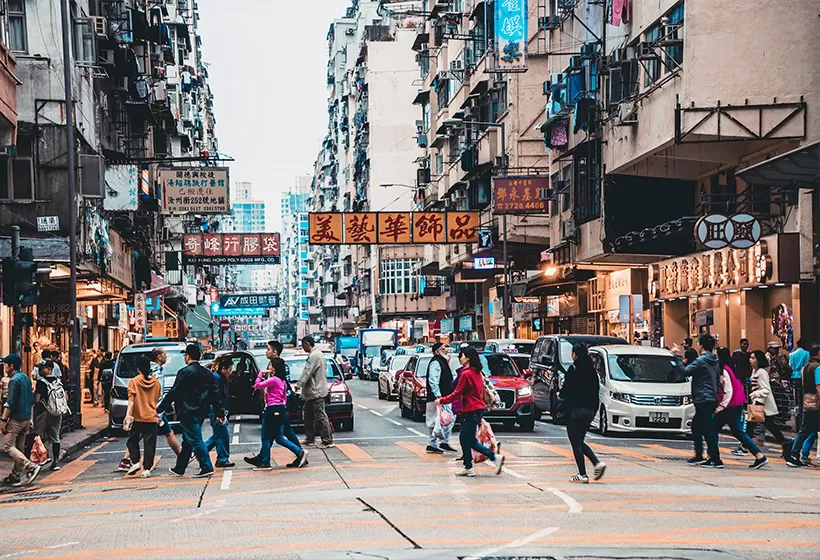Hong Kong Travel Guide
Hong Kong, as an international financial, trade center, and free port, is called the “Pearl of the Orient” and “City of Life.” After Hong Kong had been governed by England for a century and a half, it finally returned to China on July 1, 1997, as a special administrative area.
The three regions of Hong Kong
Hong Kong is divided into three areas including Kowloon, Hong Kong Island, and New Territories (offshore Islands are also included). Kowloon and HK Island face each other across Victoria Harbor. These two areas occupy a small land of HK but are the most populous places in HK. Tsim Sha Tsui in Kowloon and Central in HK Island, sitting at either bank of Victoria Harbor, are two economic and cultural centers as well as the most thriving places in this region.
The New Territories are seen as the periphery of HK. With a large area, it also includes many offshore islands. A lot of country parks and walking lanes are spread across New Territories. The well-known Lantau Island where Disneyland, Tsing Ma Bridge, the Monastery Buddha, and the international airport of HK also belong to New Territories. Nanya Island, Saigon, and Cheung Chau are all part of the offshore islands of New Territories.
Top attractions, what to do
Hong Kong, a bustling metropolis, boasts a myriad of top attractions including the towering skyscrapers of Victoria Harbour, the dazzling skyline viewed from the Peak, the traditional markets of Temple Street and Ladies Market, the culturally significant Wong Tai Sin Temple, the picturesque fishing village of Tai O, the family-friendly Disneyland and Ocean Park theme parks, the historical monuments of the Big Buddha and the Ten Thousand Buddhas Monastery, and the world-renowned cuisine ranging from street food stalls to Michelin-starred restaurants. More top attractions in Hong Kong >>
Weather, the best time to visit Hong Kong
The best time to visit Hong Kong is generally from October to early December or from March to April when the weather is mild and comfortable, with lower humidity and fewer rainy days. During these months, visitors can enjoy a pleasant climate and participate in various outdoor activities, such as hiking and sightseeing.
The summer months of June to August tend to be hot, humid, and rainy, with occasional typhoons. If you choose to visit during these months, be sure to bring appropriate clothing and gear for wet and humid conditions.
Winter months (December to February) in Hong Kong can be chilly and often damp, with occasional cold fronts blowing in from the north. While winter is the driest season, visitors should still bring a light jacket or sweater for the cool temperatures.
Hong Kong weather for your travel plan >>
Food and Cuisine, what to eat
Hong Kong offers a wide range of food options that reflect its unique cultural and historical influences.
The city's cuisine is a fusion of Cantonese, Western, and Southeast Asian flavors, and visitors can expect to find delicious street food, high-end dining options, and everything in between.
Some popular dishes include dim sum, roasted meats, egg tarts, hot pot, and seafood. Hong Kong also offers a diverse selection of international cuisine, including Italian, French, Japanese, and Indian. With its vibrant food scene and culinary innovation, Hong Kong is truly a food lover's paradise.
More about food in Hong Kong >>
Hotels, where to stay
Hong Kong has a plethora of luxury hotels that cater to the needs of travelers looking for the ultimate comfort and indulgence. Some of the top luxury hotels in Hong Kong include the Peninsula Hong Kong, Four Seasons Hotel Hong Kong, Mandarin Oriental Hong Kong, The Ritz-Carlton Hong Kong, and The Landmark Mandarin Oriental. These hotels offer a range of amenities such as world-class restaurants, opulent spa services, breathtaking views of the city, and luxurious accommodations. Whether you're traveling for business or pleasure, a stay at one of Hong Kong's luxury hotels is sure to leave you feeling pampered and rejuvenated. Best luxury hotels in Hong Kong >>
Shopping,where and what to buy
Shopping in Hong Kong is a thrilling experience that offers a wide variety of products and services for both locals and visitors. From luxury fashion brands to unique local markets, Hong Kong has something for everyone.
The shopping culture is deeply ingrained in the city's daily life, and there are numerous shopping districts to explore. Whether you're looking for high-end designer goods or affordable bargains, Hong Kong's shopping scene has it all. With its tax-free policy, competitive pricing, and convenient location, Hong Kong remains one of the world's top shopping destinations.
Cultural activities that spotlight your travel
Hong Kong is a city that offers a wealth of hands-on cultural experiences that are sure to fascinate visitors.
From learning about traditional Chinese medicine to trying out the art of calligraphy, there is no shortage of opportunities to immerse oneself in the rich history and culture of this vibrant metropolis. Whether it's exploring local markets, taking a cooking class, or attending a cultural festival, Hong Kong provides a unique and unforgettable experience for anyone looking to broaden their horizons and deepen their understanding of the world around them.
Top activities in Hong Kong >>
Travel itineraries for Hong Kong, how to plan a trip
Hong Kong is a popular tourist destination that offers a unique blend of East and West. Visitors can enjoy the city's famous skyline, delicious food, and rich culture.
When planning a trip to Hong Kong, it is important to consider factors such as the best time to visit, accommodation options, transportation, and attractions to see. By taking these into account and making the appropriate travel arrangements, visitors can have a memorable and enjoyable trip to Hong Kong.
Travel itineraries for Hong Kong in details >>

The full name of HK is Hong Kong Special Administrative Region of the Republic of China (HKSAR). HK has been a territory since the Qing Dynasty, but it had been ceded in batches and rented to England as a colony after China lost it in the middle of the 19th century, which led to the development of ports in HK. In the 1980s, China and England had an agreement on the future development of HK and signed the Sino-British Joint Declaration which specified the Republic of China would resume its rule over HK. China promised to govern the country under the policy of “one country, two systems” in which HK would maintain its capitalist regime and the previous lifestyles, and enjoy a high degree of autonomy in all areas except diplomatic affairs and defense, which was called “Hong Kong people ruling Hong Kong with a high degree of autonomy.”
After the Second World War, HK witnessed the rapid development of its economy and society of HK, not only becoming one of the Four Asian Tigers, but also one of the regions with the most advanced economy and highest living standards. HK is an important financial, service, and shipping center in Asia, famous for its government, stable public security, free economic system, and rule of law. The historical vicissitudes transformed HK from a small fishing village with only 5,000 people to an international metropolis reputed as the “Pearl of Orient” today.
Why is the name Hong Kong
As regards the name of Hong Kong, there are two sayings throughout the region. It was said that the name is relevant to spices. In the Song and Yuan Dynasties, HK was affiliated with Dongguan, Guangdong Province in terms of administration. Beginning in the Ming Dynasty, a small port in the north of HK was a feeder port for transporting Nanyue spices which were produced in Dongguan, Guangdong province, thus the name of fragment harbor (Hong Kong). It was said that the spices shipped in HK had superior quality and were called the “Treasures of Hainan.” Many local people of HK were engaged in planting spices so HK became famous for its spices. Soon, this kind of spice was listed as one of the tributes to the emperor, which prospered the industry of spice manufacturing and shipping. Then the plantation and transportation of spices gradually decreased, but the name remained.
The second saying is that HK is a natural harbor with sweet stream water nearby where sailors used to come to drink water. After a long time, as the sweet stream water rose to fame, the stream was called “fragment river,” this river flew into the sea and formed a small alluvial harbor and since then it was called “Hong Kong.” Many British people named this island “HK” as they disembarked at this harbor when they went to HK Island. Until today, “Fragment River” (香江) is still another name for “Hong Kong.”
Although there are different sayings to explain the name that was given to Hong Kong, it is almost certain that this name first appeared in Ming Dynasty. It referred to a small harbor, and village and then was used to describe the whole island (HK island). In the early 19th century, it was known as the name of the entire area occupied by British colonizers.
You might also like the following helpful information about Hong Kong

- When is the best time or season to visit Hong Kong
- Top attractions you might like in Hong Kong
- Choose your food and restaurants while traveling in Hong Kong
- Do not know where to stay? Visit the best hotels in Hong Kong
- To know more about Hong Kong, visit its culture
- What to buy and where to shop in Hong Kong?
- Enjoy an interesting and colorful nightlife
- Effiently tour around by learning the transportation
- Bank and currency, help you save money
GREAT FAMILY CHINA TOUR
JULY 2024 We wanted to thank Grace at China Culture tour for organizing a great tour of China. We enjoyed our Beijing - Xian-Chengdu -Guilin -Yangshuo - Shanghai trip. Our local guides Bruce in Beijing, Susan in Xian, Jane in Chengdu, Mike in Guilin and Mary in Shanghai took care of us…read more details »
Teng Han L from SINGAPORE
Ready to Create a Unique Dream Travel?

